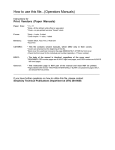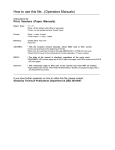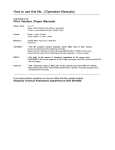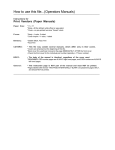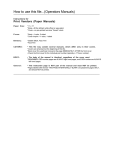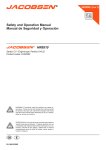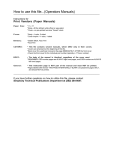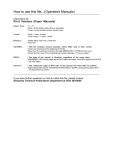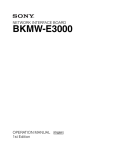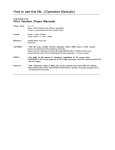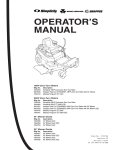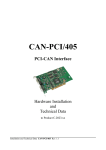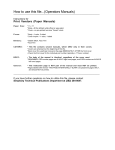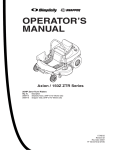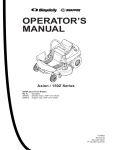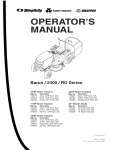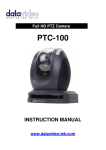Download Simplicity 1691339 Operator`s manual
Transcript
How to use this file...(Operators Manuals) ————————————————————————————————————————————––– Instructions for Print Vendors (Paper Manuals) Paper Size: * 11 x 17 * Body—50 lbs brilliant white offset or equivalent. * Cover—on pre-printed two-tone “Swash” stock. Press: * Body—1-color, 2-sided * Cover imprint —1-color, 1-sided Bindery: * Saddle Stitch, Face Trim, 3-Hole Drill * Face Trim COVERS: * This file contains several manuals, which differ only in their covers. * Covers are all present at the beginning of this file. * Back cover for a particular manual is the page IMMEDIATELY AFTER the front cover. • Check the front cover for the individual part number (typically a 171xxxx number). BODY: • The body of the manual is identical, regardless of the cover used. * REMEMBER: ODD number pages are ALWAYS right hand pages, and EVEN number are ALWAYS left hand pages. General: * This instruction page is NOT part of the manual and must NOT be printed. • Pages labeled with the text “THIS PAGE INTENTIONALLY BLANK” are placement pages ONLY, and should NOT be printed. ————————————————————————————————————————————––– If you have further questions on how to utilize this file, please contact Simplicity Technical Publications Department at (414) 284-8650. THIS PAGE INTENTIONALLY BLANK Replacement OPERATOR’S MANUAL SunStar / 1900 / 2900 Series 18HP Hydro Tractors 48” Mower Decks Mfg. No. 1692521 1692523 1692525 Mfg. No. 1690986 1691183 Description SunStar, 18HP Hydro 1918H, 18HP Hydro 2918H, 18HP Hydro 20HP Hydro Tractors Mfg. No. 1692454 1692456 1692458 1692460 1692505 1692507 Description SunStar, 20HP Hydro SunStar, 20HP Hydro 1920H, 20HP Hydro 1920H, 20HP Hydro 2920H, 20HP Hydro 2920H, 20HP Hydro Description 48” Mower Deck 48” Mower Deck 60” Mower Decks Mfg. No. 1691339 1691344 Description 60” Mower Deck 60” Mower Deck Note: This Replacement Operator’s Manual is a reprint of a manual no longer in production, but contains the same information as the Operator’s Manual furnished with the original tractor. 1714289-01 1714298-01 1714411-01 Rev 2/1995 TP 100-1424-01-SS-SMA MANUFACTURING, INC. 500 N Spring Street / PO Box 997 Port Washington, WI 53074-0997 www.simplicitymfg.com © Copyright 1998, Simplicity Manufacturing, Inc. All Rights Reserved. Printed in USA. Table Of Contents Troubleshooting The Tractor ..............................................20 Troubleshooting The Mower ...............................................21 Checking the Battery ..........................................................21 Charging A Completely Discharged Battery ..........................................................22 Jump Starting with Auxiliary (Booster) Battery ...............................................22 Bulb Replacement ..............................................................23 TRACTOR & MOWER IDENTIFICATION .....................2 SAFETY RULES ............................................................3 SAFETY DECALS .........................................................5 FEATURES & CONTROLS ...........................................6 Tractor Controls ....................................................................6 Safety Interlock System ........................................................7 OPERATION ..................................................................8 General.................................................................................8 Mower Installation & Removal .............................................8 Checks Before Starting.......................................................10 Starting The Engine............................................................10 Selecting Axle Speed Range (20 HP Models Only) ...........10 Operation............................................................................11 Stopping the Tractor ...........................................................11 Pushing the Tractor by Hand .............................................11 ADJUSTMENTS ..........................................................24 Seat Adjustment .................................................................24 Brake Adjustments .............................................................24 Front Clutch Adjustment .....................................................25 Leveling the Mower ............................................................25 Adjustments for the 60” Mower...........................................26 Blade Brake Adjustment .....................................................26 MOWING PATTERN & TIPS .......................................12 BELT REPLACEMENT................................................27 Tractor PTO Belt.................................................................27 Mower Belt..........................................................................27 NORMAL CARE ..........................................................13 Schedule.............................................................................13 Raising the Hood ...............................................................13 Checking/Adding Gasoline .................................................13 Checking Tire Pressure ......................................................13 Checking the Fuel Filter......................................................13 Lubrication ..........................................................................14 Checking Transmission Fluid..............................................15 Changing Transmission Fluid & Filter.................................16 Battery Maintenance...........................................................16 Servicing the Mower Blades ...............................................17 SPECIFICATIONS .......................................................28 PARTS & ACCESSORIES ..........................................30 Common Replacement Parts..............................................30 Maintenance Items .............................................................30 Optional Accessories..........................................................31 Technical Literature ............................................................31 INTERNATIONAL SYMBOLS .....................................32 NOTE: In this manual, “left” and “right” are referred to as seen from the operating position. STORAGE ...................................................................18 Temporary Storage.............................................................18 Long Term Storage.............................................................18 Starting After Long Term Storage.......................................19 WARNING Engine exhaust from this product contains chemicals known, in certain quantities, to cause cancer, birth defects, or other reproductive harm. TROUBLESHOOTING & REPAIR...............................20 General...............................................................................20 1 Tractor & Mower Identification Record your model number, manufacturer number and engine serial number in the space provided for easy reference. The models and manufacturer numbers covered in this manual are listed on the front cover. MODEL REFERENCE Model Number: The tractor I.D. tag is located on the left-side, front of the frame, as shown below. The mower deck I.D. tag is also on the left side, on top of the mower deck, towards the rear. Manufacturer Number: Engine I.D. Number: Refer to the engine Owner’s Manual for location of engine serial number. Dealer Name/Date Purchased: Be sure to fill out and return the Warranty Registration Card supplied with your tractor. Tractor Identification Tag Mower Identification Tag Figure 1. Tractor & Mower Identification Tags 2 Safety Rules Read these safety rules and follow them closely. Failure to obey these rules could result in loss of control of rider, severe personal injury or death to you, or bystanders, or damage to property or equipment. This mowing deck is capable of amputating hands and feet and throwing objects. The triangle in text signifies important cautions or warnings which must be followed. GENERAL OPERATION WARNING - SLOPE OPERATION Never operate on slopes greater than 30 percent (16.7°) which is a rise of three feet vertically in 10 feet horizontally. When operating on slopes that are greater than 15 percent (8.5°) but less than 30 percent use front counterweights and rear wheel weights (see your dealer). Select slow ground speed before driving onto slope. In addition to front and rear weights, use extra caution when operating on slopes with rearmounted grass catcher. Mow UP and DOWN the slope, never across the face, use caution when changing directions and DO NOT START OR STOP ON SLOPE. • Read, understand, and follow all instructions in the manual and on the unit before starting. • Only allow responsible adults, who are familiar with the instructions, to operate the unit. • Clear the area of objects such as rocks, toys, wire, etc., which could be picked up and thrown by the blade(s). • Be sure the area is clear of other people before mowing. Stop unit if anyone enters the area. Do • Never carry passengers. • See your authorized dealer for recommendations of wheel weights or counterweights to improve stability. • Do not mow in reverse unless absolutely necessary. Always look down and behind before and while travelling in reverse. • Mow up and down slopes, not across. • Remove obstacles such as rocks, tree limbs, etc. • Be aware of the mower discharge direction and do not point it at anyone. Do not operate the mower without either the entire grass catcher or the deflector in place. • Watch for holes, ruts, or bumps. Uneven terrain could overturn the unit. Tall grass can hide obstacles. • Slow down before turning. • Use slow speed. Choose a low gear so that you will not have to stop or shift while on the slope. • Never leave a running unit unattended. Always disengage the PTO, set parking brake, stop engine, and remove keys before dismounting. • Use extra care with grass catchers or other attachments. These can change the stability of the unit. • Keep all movement on the slopes slow and gradual. Do not make sudden changes in speed or direction. • Turn off the PTO switch to disengage the blades when not mowing. Do Not • Stop engine before removing grass catcher or unclogging chute. • Do not start or stop on a slope. If tires lose traction, disengage the blade(s) and proceed slowly straight down the slope. • Mow only in daylight or good artificial light. • Do not operate the unit while under the influence of alcohol or drugs. • Do not turn on slopes unless necessary, and then, turn slowly and gradually downhill, if possible. • Watch for traffic when operating near or crossing roadways. • Do not mow near drop-offs, ditches, or embankments. The mower could suddenly turn over if a wheel is over the edge of a cliff or ditch, or if an edge caves in. • Use extra care when loading or unloading the unit into a trailer or truck. SLOPE OPERATION • Do not mow on wet grass. Reduced traction could cause sliding. Slopes are a major factor related to loss-of-control and tip-over accidents, which can result in severe injury or death. All slopes require extra caution. If you cannot back up the slope or if you feel uneasy on it, do not mow it. • Do not try to stabilize the unit by putting your foot on the ground. • Do not use grass catcher on steep slopes. 3 Safety Rules running. Allow engine to cool before refueling. Do not smoke. CHILDREN Tragic accidents can occur if the operator is not alert to the presence of children. Children are often attracted to the unit and the mowing activity. Never assume that children will remain where you last saw them. c) Never refuel the unit indoors. • Never run a unit inside an enclosed area. • Keep nuts and bolts, especially blade attachment bolts, tight and keep equipment in good condition. • Keep children out of the mowing area and under the watchful care of another responsible adult. • Be alert and turn unit off if children enter the area. • Never tamper with safety devices. Check their proper operation regularly. • Before and when backing, look behind and down for small children. • Keep unit free of grass, leaves, or other debris buildup. Clean up oil or fuel spillage. • Never carry children. They may fall off and be seriously injured or interfere with safe unit operation. • Stop and inspect the equipment if you strike an object. Repair, if necessary, before restarting. • Never allow children to operate the unit. • Use extra care when approaching blind corners, shrubs, trees, or other objects that may obscure vision. • Never make adjustments or repairs with the engine running unless spedified otherwise in the engine manufacturer’s manual. TRANSPORTING AND STORAGE • Always observe safe refueling and fuel handling practices when refueling the tractor after transportation or storage. • Grass catcher components are subject to wear, damage, and deterioration, which could expose moving parts or allow objects to be thrown. Frequently check components and replace with manufacturer’s recommended parts, when necessary. • Always follow the engine manual instructions for storage preparations before storing the tractor for both short and long term periods. • Mower blades are sharp and can cut. Wrap the blade(s) or wear gloves, and use extra caution when servicing them. • Always follow the engine manual instructions for proper start-up procedures when returning the unit to service. • Check brake operation frequently. Adjust and service as required. • Use only factory authorized replacement parts when making repairs. • Never store the unit or fuel container inside where there is an open flame or pilot light, such as in a water heater. Allow unit to cool before storing. • Always comply with factory specifications on all settings and adjustments. SERVICE AND MAINTENANCE • Only authorized service locations should be utilized for major service and repair requirements. • Use extra care in handling gasoline and other fuels. They are flammable and vapors are explosive. • Never attempt to make major repairs on this unit unless you have been properly trained. Improper service procedures can result in hazardous operation, equipment damage and voiding of manufacturer’s warranty. a) Use only an approved container. b) Never remove gas cap or add fuel with the engine 4 Safety Decals This unit has been designed and manufactured to provide you with the safety and reliability you would expect from an industry leader in outdoor power equipment manufacturing. your tractor and mower should be carefully read and obeyed. Personal bodily injury can result when these instructions are not followed. The information is for your safety and it is important! The safety decals shown below are on your tractor and mower. Although reading this manual and the safety instructions it contains will provide you with the necessary basic knowledge to operate this equipment safely and effectively, we have placed several safety labels on the unit to remind you of this important information while you are operating your tractor. If any of these decals are lost or damaged, replace them at once. See your local dealer for replacements. These labels are easily applied and will act as a constant visual reminder to you, and others who may use the equipment, to follow the safety instructions necessary for safe, effective operation. All WARNING, CAUTION and instructional messages on Decal - PTO Shield Part No. 1679117 Decal - Console (20 HP Model shown) Part No. 1714633 - 18 HP Model Part No. 1714160 - 20 HP Model Decal - Battery Warning Part No. 1679675 Decal - Danger Part No. 1704277 Decal - Danger Part No. 1704276 5 Features & Controls TRACTOR CONTROLS *1322 Y *1323 Right Side Left Side X Figure 2. Tractor Controls REF A NAME Mower Height Control Lever FUNCTION Controls mower cutting height. B Lift Lever, Hydraulic Lifts and lowers attachments. C Lift Lever, Dual (Optional) Allows use of second hydraulic function. D Engine Speed Controls engine speed. E Choke Engages/disengages engine choke for starting. F Oil Light (Red) Lights up to indicate low oil pressure. G Neutral Light (Green) Lights up to indicate when ground speed control lever is in neutral H Voltmeter With engine stopped, shows voltage of battery. With engine running, shows voltage of charging system. (20 HP models only.) I Hourmeter Records running time. J Fuel Gauge On 20 HP models, dash mounted gauge shows amount of fuel in tank. On 18 HP models, the fuel gauge is built into the fuel tank cap. K Front PTO Light (Red) Lights up to indicate when front PTO is engaged. L Seat Light (Green) Lights up to indicate when operator is present in seat. M Ground Speed Control Lever Controls forward and reverse ground speeds. N Brake Pedals Stops tractor. O PTO Switch Engages and disengages power to attachments. P Ignition Switch & Key Starts and stops engine. Q Parking Brake Holds tractor in stationary position. R Two-Speed Axle Shift (20 HP) Selects high, neutral or low gear range. Neutral position used to push tractor manually with engine off. S Hood Latch One on each side of hood. Pull down and out to release and raise hood. T Pedal Lock Locks pedals together. U Rear PTO Switch (Optional) Engages and disengages power to rear attachment. V Seat Switch Shuts off engine if operator leaves seat when hydrostatic control lever is in forward or reverse slot. W Release Valve (18 HP) Allows tractor to be pushed manually with engine off. X Headlight Switch Turns headlight on or off. Y Rear PTO Light (Red) (Optional) Lights to indicate when rear PTO is engaged. 6 Features & Controls SAFETY INTERLOCK SYSTEM *2374 Your tractor is equipped with a seat switch safety system that will automatically shut the engine off when the operator leaves the seat with the ground speed control lever in gear or with the PTO engaged. Once the engine has stopped, the electric PTO switch must be turned off after operator returns to the seat in order to start the engine. Check operation of dash safety lights. With operator in seat and ignition switch turned to ON (engine not running): A. Neutral Indicator Light (G, figure 2) should go on with ground speed control lever in neutral gate and should go out when lever is moved to either the forward or reverse gate. B. Front PTO Indicator Light (K, figure 2) should go on and off with operation of PTO switch. Figure 3. Seat Switch A. Switch C. Oil Pressure Indicator Light (F, figure 2) should be on and should go out immediately after engine starts. Test 3 - Engine should shut off if: B. Wiring Harness D. Operator Seated Indicator Light (L, figure 2) should go on when operator is present in the seat and should go off as operator rises out of the seat. A. operator rises off seat with ground speed control lever in gear. Check the seat switch (A, figure 3) every fall and spring with the following four tests: NOTE: If operator returns to seat before engine stops, the engine will re-start and PTO clutch will re-engage. Test 1 - Engine should NOT crank if: Test 4 - PTO will disengage if: A. seat is not occupied or A. operator rises off seat with engine running. B. ground speed control lever out of neutral or NOTE: If operator returns to seat before engine stops, the engine will re-start and PTO clutch will re-engage. B. operator rised off seat with PTO engaged. C. PTO switch engaged. WARNING Test 2 - Engine should crank if: If the tractor does not pass the test, do not operate tractor. See your authorized dealer. Under no circumstances should you attempt to defeat the purpose of the safety system. A. seat is occupied and B. ground speed control lever is in neutral and C. PTO switch is disengaged. 7 Operation GENERAL Before operating this tractor for the first time, the owner should operate in an open area without mowing, to become accustomed to the unit. The left side of the mower can be used to trim close to objects. Be sure to read all information in the Safety and Operation sections before attempting to operate this tractor and mower. CAUTION ON 18 HP MODELS, towing the tractor will cause transmission damage. Do not use another vehicle to push or pull tractor. CAUTION WARNING - SLOPE OPERATION Never operate on slopes greater than 30 percent (16.7°) which is a rise of three feet vertically in 10 feet horizontally. When operating on slopes that are greater than 15 percent (8.5°) but less than 30 percent use front counterweights and rear wheel weights (see your dealer). Select slow ground speed before driving onto slope. In addition to front and rear weights, use extra caution when operating on slopes with rearmounted grass catcher. Mow UP and DOWN the slope, never across the face, use caution when changing directions and DO NOT START OR STOP ON SLOPE. ON 20 HP MODELS, shift 2-speed axle to neutral before towing. Do not tow faster than 8 mph, maximum vehicle speed. Towing in gear will result in damage to the hydrostatic transmission. WARNING To reduce fire hazard, keep the engine and mower free of grass, leaves and excess grease. WARNING Never allow passengers to ride on the unit. CAUTION Do not attempt to move the ground speed control lever when the parking brake is engaged or the service brakes are being applied. Equipment damage will occur. WARNING The interlock safety switches are for your safety. Do not attempt to bypass them. MOWER INSTALLATION & REMOVAL *2528 C D WARNING Stop engine and remove key. Do not engage PTO until mower is completely installed or removed and operator is seated. NOTE: Perform mower installation and removal on a hard, level surface such as a concrete floor. NOTE: The size and weight of the 60” mower makes it difficult to slide under tractor. To install or remove 60” mower, raise front of tractor. Figure 4. Mower Hitch A. Tractor Hitch B. Mower Hitch Arm Installation 1. Place mower in low cut position and slide mower under left side of tractor. Note that the frame is notched to allow clearance. Turn the wheels fully to the right and lift hitch arms over wheel as necessary. C. Pin D. Hairpin Clip *1384 2. For now, align the mower hitch with the tractor hitch as shown in figure 4. Connecting the hitch comes later in the installation. Figure 5. Mower Drive Shaft A. Locking Ring B. Coupler 8 Operation 3. The mower drive shaft connects to the tractor drive shaft by a series of retracting balls located under the locking ring (A, figure 5). When the locking ring is released, the balls lock into a groove on the tractor drive shaft. To connect the drive shaft, proceed as follows: *1681 A. Place the mower drive shaft barely onto the tractor drive shaft. Turn the coupler (B, figure 5) to align the splines. B. Pull the locking ring (A, figure 5) back, then push the mower drive shaft onto the tractor drive shaft, past the groove. Figure 6. Lift Chains A. Clevis B. Pin C. Grasp the coupler and pull back. The locking ring will snap forward into the locked position when the balls are seated in the groove. C. Chain D. Hairpin clip D. Test the connection by pulling back on the coupler. You should not be able to pull it off. 4. Raise mower to mid-cut position. See figure 6. Hook the chains (C) to the clevis (A) on each side of the gear box. Insert pin (B) through clevis and chain, then install hairpin clip (D) in pin. Hairpin clip should be installed towards the inside as shown. NOTE: When connecting mower deck to tractor, use 3 links of chain. **1384 5. Start the engine and turn the front wheels straight ahead. Using the hydraulic lift lever (B, figure 2), raise the mower to full transport position, then shut off the engine. Figure 7. Mower Installed -Viewed From Right Side A. Chain C. Hitch B. Drive Shaft 6. Use the following procedure to connect the hitch arms (B, figure 4). 1. Use the mower height control lever (A, figure 2) and place mower in the 2nd notch from the high cut position. Removal A. Place the mower height control lever (A, figure 2) in the second notch from high cut position. This should align the hitch. 2. With the engine running, use the hydraulic lift lever (B, figure 2) to raise the mower to the transport position, then shut off the engine and remove the key to prevent accidental starting. B. Use your right hand to apply pressure on the mower height control quadrant brace in order to maneuver mower hitch arm(B, figure 4) into the tractor hitch (A, figure 4). When aligned, use your left hand to insert pins through mower hitch arms and tractor hitch. Insert pins so the hole is vertical to aid in hairpin clip installation. Install hairpin clips in both pins. 3. Remove the pins and clips from hitch (figure 5). Push back on height control lever to aid removal of pins and to maneuver mower. 4. Move the lift lever (B, figure 2) forward to lower the mower. 5. Disconnect the drive shaft by pulling back on the locking ring and pulling coupler toward the rear. NOTE: Align holes by applying rearward pressure on the mower height control lever. 6. With mower in high cut position, disconnect the chains (figure 7). 7. Figure 7 shows mower installed, as viewed from the right side. 7. Place mower in low cut position and turn wheels fully right. Mower can be removed. Tractor frame is notched for gear box clearance. 9 Operation *1323 Figure 9. Two-Speed Axle Shift (20 HP Models) A. Axle Shift Lever STARTING THE ENGINE Figure 8. Tractor Controls A. Seat Light G. B. Ground Speed H. Control Lever I. C. Parking Brake Knob J. D. Brake Pedals K. E. Front PTO Switch L. F. Rear PTO Switch (Optional) Refer to figure 8. Front PTO Light Choke Knob Throttle Lever Ignition Switch Key Brake Pedal Lock Lift Lever, Hydraulic 1. Operator must be seated. Seat light (A) will light up when key is turned on. 2. Place ground speed control lever (B) in neutral. Set parking brake. To set, lock brake pedals together with the pedal lock (K), depress pedals, pull parking brake knob (C) out, then release pedals. 3. PTO switch(es) (E & F) must be in OFF position. PTO light (G) will not be on. 4. On a cold engine, pull out choke knob (H). On a warm engine, push choke knob in. CHECKS BEFORE STARTING 5. Place throttle lever (I) midway between slow and fast (Start/Stop position). 1. Make sure you have proper wheel or counterweights if required. See SLOPE OPERATION in the Safety Rules section. Make sure any slopes are within required limits. 2. Check that crankcase is filled to full mark on dipstick. See the engine Operator’s Manual for instructions and oil recommendations. 3. Make sure all nuts, bolts, screws and pins are in place and tight. 4. Make sure you can reach all controls from operator’s positions. If not, see SEAT ADJUSTMENT. 6. Turn key (J) to start engine. Push choke in as engine warms up. 7. Allow engine to warm up for a couple of minutes before applying load. Do not idle engine for prolonged periods or carbon buildup may occur. WARNING Make sure desired direction of travel is clear of objects, people and animals. 5. Fill the gasoline tank with fresh gasoline. Fill to bottom of filler neck to avoid spillage and overflow. DO NOT mix oil with gasoline. Refer to engine manual for gasoline recommendations. SELECTING AXLE SPEED RANGE (20 HP Models Only) 1. The axle shift lever (figure 9) is designed to fit very flush with the rear foot deck panel to avoid accidental shifting. Select low speed (bottom position) for heavy work or high speed (upper position) for traveling to work areas. WARNING Gasoline is highly flammable and must be handled with care. Never fill the tank when the engine is still hot from recent operation. Do not allow open flame, smoking or matches in the area. Avoid over-filling and wipe up any spills. 2. Rock the tractor back and forth slightly to make shifting easier. 10 Operation 3. Make sure lever is firmly seated all the way in the low range or high range slot before operating tractor. 4. To set parking brake depress brake pedals, pull parking brake knob (C) out, then release pedals. OPERATION 5. Push hydraulic lift lever forward to lower attachment. 6. Turn ignition off and remove key to prevent unauthorized use. Refer to figure 8. 1. Press pedals (D) to release parking brake. WARNING 2. Move ground speed control lever (B) to forward or reverse to start into motion. The farther lever is moved, the faster the ground speed. Place throttle lever in forward (fast) position. Before leaving operator’s position for any reason, engage the parking brake, disengage the PTO(s), stop the engine and remove the key. 3. Push the hydraulic control lever (L) forward to lower the attachment. Pull lever back to raise the attachment. PUSHING THE TRACTOR BY HAND 4. Use the PTO switch(es) (E & F) to engage or disengage the attachment. Lift switch to engage. 18 HP Models 5. The brake pedals can be used to help make sharp turns. Press the right pedal to aid a right-hand turn; press the left pedal to aid in making a left-hand turn. When driving at high speed, such as traveling to a work site, keep the brake pedals locked together. Forward ground speed is reduced by 1/2 when depressing one pedal. Release lever is located just ahead of left rear fender. 1. To actuate release lever, push lever down firmly and hold for a few seconds before releasing. 2. Push tractor by hand with the engine off. 20 HP Models STOPPING THE TRACTOR 1. Set the axle shift lever (figure 9) to the neutral position. Refer to figure 8. 2. Push tractor by hand with the engine off. 1. Move ground speed control lever (B) to neutral and depress brake pedals. WARNING 2. Switch PTO to off. Do not tow the tractor. Damage will result to the transmission/transaxle. 3. Move throttle midway between slow and fast position before shutting off engine. 11 Mowing Patterns & Tips • Aerate lawn in spring, consider renting an aerator which removes cores of soil from the lawn. This increases the speed of clipping decomposition and deep root growth by opening up the soil and permitting greater movement of water, fertilizer and air. • Don’t over-water. Too much water can encourage disease development. • Mow when the grass is dry, preferably in the late afternoon when the temperatures are cooler. • Where possible, change patterns occasionally to eliminate matting, graining or a corrugated appearance. • For wet grasses, grasses prone to wheel tracking and for collecting clippings: a. Use sharp blades. For the first use of the mower, choose a smooth level area. Cut long straight strips overlapping slightly. The size and type of area to be mowed determines the best mowing pattern to use. Obstructions such as trees, fences and buildings must also be considered. Where possible, make one or two passes in a counterclockwise direction around the outside of the area to keep the cut grass off fences and walks. The remainder of the mowing should be done in a clockwise direction so the clippings are dispersed on the cut area. Keep in mind the following lawn care and mowing tips: • Too much maintenance is as detrimental to your lawn as neglect. • Mow when grass is 3-5 inches tall. Don’t cut shorter than 2 to 2-1/2 inches. Cut only the top one-third of the grass blade. Cutting below this level can lead to thatch problems. Your mower has a cutting height adjustment that can help you maintain a proper length. • For extremely tall grass, set the cutting height at maximum for the first pass, and then reset to the desired height and mow again. • Mow often. Short clippings of an inch or less decompose more quickly than longer blades. • Keep the blades on your mower sharp for finer clippings. • Let grass grow a bit longer when it is hot to reduce heat build-up and protect grass from heat damage. • Use slow-release fertilizer for slow, even growth. • Don’t cover grass surface with a heavy layer of clippings. Consider using a grass collection system and starting a compost pile. b. Raise deck 1/4” higher in front than in rear. c. Run at maximum engine speed but slow ground speed. d. Clean deck of built-up material/caked-on grass. e. Check for free movement of mower idler pulley. • For dry conditions where grass blow-out is a problem: a. Use sharp blades. b. Raise deck so the front is even with, or 1/8” lower than, rear. c. Use 3/4 engine speed. d. Clean deck of built-up material/caked-on grass. 12 Normal Care SCHEDULE The following schedule should be followed for normal care of your tractor and mower. You will need to keep a record of your operating time. See Page 7 Every 100 Hours *Or Yearly ● Check tractor brakes. 24 ● Normal Care Items Check tractor & mower for loose hardware. – ● Clean heat exchanger. - ● Clean hydrostatic cooling fins with compressed air. - ● Check tires. 13 ● Lubricate tractor and mower. 14 Oil Pivot points. 15 Check transmission fluid. 15 Change transmission fluid & filter. 16 Check and clean battery. 16 Clean, sharpen and balance blades. 17 ● - ● Safety Items Check safety interlock system. Clean and repack front wheel bearings. Every 5 Hours Every 25 Hours ● ● ● Trans. service only or every 400 hours. ● See engine manual for engine care & maintenance. * or as needed. RAISING THE HOOD CHECKING TIRE PRESSURE To gain access to the engine compartment, release the rubber strap (S, figure 2) on each side of the hood and raise the hood. Front tire pressure should be 12 to 15 psi (82 to 103 kPa). Rear tire pressure should be 6 to 8 psi (41 to 55 kPa). CHECKING FUEL FILTER CAUTION Do not run the engine with the hood raised. Engine heat will cause damage to the headlight bezel and hood. WARNING Do not remove fuel filter when engine is hot, as spilled gasoline may ignite. DO NOT spread hose clamps further than necessary. Ensure clamps grip hoses firmly over filter after installation. CHECKING/ADDING GASOLINE Check the gas gauge/cap to be sure there is enough gasoline to complete the job. To add gasoline, remove the gas gauge/cap. Do not overfill. Leave room in the tank for fuel expansion. Refer to your engine manual for gasoline recommendations. Install and hand tighten the gas gauge/cap. The fuel filter is located in fuel line between fuel tank and carburetor. If filter is dirty or clogged, replace as follows. Place a container below filter to catch spilled gasoline. 1. Using a pliers, open and slide hose clamps from fuel filter. 2. Remove hoses from filter. 3. Install new filter in proper flow direction in fuel line. Secure with hose clamps. See warning at beginning of procedure. CAUTION Never use gasoline containing METHANOL, gasohol containing more than 10% ethanol, gasoline additives, premium gasoline, or white gas because engine/fuel system damage could result. 13 Normal Care LUBRICATION Tractor & Mower Lubrication Lubricate the tractor and mower as shown in figures 10 18. When a grease gun is shown, wipe the fitting clean, apply two or three shots of lithium base automotive grease, and wipe off excess grease. When an oil can is shown, wipe the area clean, apply a few drops of oil (SAE 30), then wipe up drips or spills. *1873 *1875 Figure 12. Center Front Axle and Wheels *2528 Figure 10. Engine Drive Shaft *1681 Figure 13. Front Axle and Spindle *1874 Figure 11. Gear Box Fluid Check Figure 14. Foot Pedal Assembly 14 Normal Care *1872 *1384 Figure 15. PTO Idler Assembly Figure 17. Mower Drive Shaft *1684 *1606 Figure 16. Mower Belt Idler (Grease fitting located under rubber plug on arbor cover) Checking Mower Gear Box Fluid 1. See figure 11. Remove check plug on left-hand side of gear box. 2. Fluid should be at bottom of hole when mower is level. Add SAE 85W-90 gear oil as necessary. Figure 18. Mower Arbor 3. Install check plug. *1648 Oil Pivot Points A few drops of engine oil should be placed on the pivot points and moving parts of the tractor and mower. Keep oil off belts and pulleys to prevent belt damage. Place oil at all points where metal parts rub together, such as rods and rod guides, levers, etc. Oil all shaft splines. CHECKING TRANSMISSION FLUID Check with the engine off. See figure 19. fluid should be visible in tube at rear of tractor with rear access panel removed. Fluid should not extend more than 1” above fitting. Figure 19. Transmission Fluid Check A. Hydraulic Tube B. Drain Plug To add fluid, raise hood and add at fill tube (D, figure 20). Fill with Type F transmission fluid. 15 Normal Care CHANGING TRANSMISSION FLUID & FILTER *2519 Transmission fluid and filter should be changed only when performing repair work or if fluid has become discolored from overheating or contamination. Perform fluid change every 400 hours of operation if no other transmission service has been done. Replace the transmission filter whenever changing transmission fluid. Make sure filter base and surrounding area is absolutely clean before removing old filter. 1. Drain hydrostatic system by removing drain plug (B, figure 19). Drain fluid into a suitable container. 2. Clean base and replace filter using an appropriate filter wrench. Reinstall drain plug. D 3. Add Type F transmission fluid. Capacity is 6 quarts (5.7 L). 4. Run tractor for several minutes until transmission is warm and check fluid level in tube (A, figure 19). Figure 20. Battery Compartment A. Positive Battery Terminal C. Filler Caps B. Negative Battery Terminal D. Transmission Fill Tube BATTERY MAINTENANCE Checking the Battery Fluid 1. Raise the hood. 2. Remove battery filler cap. Fluid must be even with split ring full mark. If not, add distilled water. 3. Reinstall filler cap. Cleaning the Battery and Cables 1. Disconnect the cables from the battery, negative cable first (B, figure 22). 2. Remove the battery clamp, then remove the battery. WARNING 3. Scrub the battery, cables and battery compartment with baking soda and water. 4. Clean the battery terminals and cable clamps with a wire brush and battery post terminal cleaner. Be careful when handling the battery. Avoid spilling electrolyte. Keep flames and sparks away from the battery. 5. Reinstall battery and clamp. WARNING 6. Connect cables, positive cable first. When removing or installing battery cables, disconnect the negative cable FIRST and reconnect it LAST. If not done in this order, the positive terminal can be shorted to the frame by a tool. 7. Coat cable clamps and terminals with grease or petroleum jelly. 16 Normal Care *1687 *169 Workbench Loosen Thin Finishing Nail Figure 22 Balancing The Blade Blade Mounting Capscrew *1688 Wooden Block Tighten Figure 21. Removing The Blade SERVICING THE MOWER BLADES 1. Remove mower from the tractor. 2. Blades should be sharp and free of nicks and dents. If not, sharpen blades as described in following steps. 3. To remove blade for sharpening, use wooden block to hold blade while removing the blade mounting capscrew (figure 21). 4. Use a file to sharpen blade to fine edge. Remove all nicks and dents in blade edge. If blade is severely damaged, it should be replaced. Figure 23. Installing The Blade A. Wooden Block C. Cup Washer B. Spline Washer D. Capscrew 5. Balance the blade as shown in figure 22. Center the blades’ hole on a nail lubricated with a drop of oil. A balanced blade will remain level. 6. Reinstall each blade with the tabs pointing up toward deck as shown in figure 23. Secure with a capscrew (D), cup washer (C) and spline washer (B). Use a wooden block to prevent blade rotation and torque capscrews to 50-70 ft.lbs. (67-95 Nm.). WARNING For your personal safety, blade mounting capscrews must each be installed with a cup washer and spline washer, then securely tightened. Torque blade mounting capscrew to 50-70 ft.lbs. (67-95 N.m.) WARNING For your personal safety, do not handle the sharp mower blades with bare hands. Careless or improper handling of blades may result in serious injury. 17 Storage WARNING Never store the tractor, with gasoline in engine or fuel tank, in a heated shelter or in enclosed, poorly ventilated enclosures. Gasoline fumes may reach an open flame, spark or pilot light (such as a furnace, water heater, clothes dryer, etc.) and cause an explosion. Handle gasoline carefully. It is highly flammable and careless use could result in serious fire damage to your person or property. Drain fuel into an approved container outdoors away from open flame or sparks. b. Clean underside of mower deck. TEMPORARY STORAGE (30 Days Or Less) c. Coat all bare metal surfaces with paint or light coat of oil to prevent rusting. Remember, the fuel tank will still contain some gasoline, so never store the tractor indoors or in any other area where fuel vapor could travel to any ignition source. Fuel vapor is also toxic if inhaled, so never store the tractor in any structure used for human or animal habitation. 3. Clean external surfaces and engine. 4. Prepare engine for storage. See engine owner’s manual. 5. Clean any dirt or grass from cylinder head cooling fins,engine housing and air cleaner element. Here is a checklist of things to do when storing your tractor temporarily or in between uses: 6. Cover air cleaner and exhaust outlet tightly with plastic or other waterproof material to keep out moisture, dirt and insects. • Keep the tractor in an area away from where children may come into contact with it. If there’s any chance of unauthorized use, remove the spark plug (s) and put in a safe place. Be sure the spark plug opening is protected from foreign objects with a suitable cover. 7. Completely grease and oil tractor as outlined in the Normal Care section. 8. Clean up tractor and apply paint or rust preventative to any areas where paint is chipped or damaged. • If the tractor can’t be stored on a reasonable level surface, chock the wheels. 9. Be sure the battery is filled to the proper level with water and is fully charged. Battery life will be increased if it is removed, put in a cool, dry place and fully charged about once a month. If battery is left in tractor, disconnect the negative cable. • Clean all grass and dirt from the mower. NOTE: If storing your tractor between winter snow removal jobs in a cold area, we suggest that you fill the fuel tank at the completion of each job to prevent water condensation in the fuel tank. Wait for engine to cool before filling tank. 10. Drain fuel system completely or add a gasoline stabilizer to the fuel system. If you have chosen to use a fuel stabilizer and have not drained the fuel system, follow all safety instructions and storage precautions in this manual to prevent the possibility of fire from the ignition of gasoline fumes. Remember, gasoline fumes can travel to distant sources of ignition and ignite, causing risk of explosion and fire. LONG TERM STORAGE (Longer Than 30 Days) Before you store your tractor for the off-season, read the Maintenance and Storage instructions in the Safety Rules section, then perform the following steps: NOTE: Gasoline, if permitted to stand unused for extended periods (30 days or more), may develop gummy deposits which can adversely affect the engine carburetor and cause engine malfunction. To avoid this condition, add a gasoline stabilizer to the fuel tank or drain all fuel from the system before placing unit in storage. 1. Drain crankcase oil while engine is hot and refill with a grade of oil that will be required when tractor is used again. 2. Prepare the mower deck for storage as follows: a. Remove mower deck from the tractor. 18 Storage 11. Transport the tractor to a suitable, dry, indoor location. If the tractor is to be stored 6 months or longer, block the tractor up off the wheels to relieve weight and also to keep the tires off a damp floor. Protect tires from prolonged exposure to direct sunlight. 2. Install the battery if it was removed. 3. Unplug the exhaust outlet and air cleaner. 4. Fill the fuel tank with fresh gasoline. See engine manual for recommendations. 5. Check crankcase oil level and add proper oil if necessary. STARTING AFTER LONG TERM STORAGE 6. Inflate tires to proper pressure. Check fluid levels. Before starting the tractor after it has been stored for a long period of time, perform the following steps. 7. Start the engine and let it run slowly. DO NOT run at high speed immediately after starting. Be sure to run engine only outdoors or in well ventilated area. 1. Remove the blocks from under the tractor. 19 Troubleshooting & Repair GENERAL 5. Faulty engine electrical or fuel system. See engine manual or your dealer. WARNING To avoid serious injury, perform maintenance on the tractor or mower only when the engine is stopped and the parking brake engaged. Always remove the ignition key, disconnect spark plug wire and fasten away from the plug before beginning the maintenance, to prevent accidental starting of the engine. Engine starts hard or runs poorly. 1. Fuel mixture too rich. Clean air filter. Check choke adjustment (engine speed control). See engine manual. 2. Carburetor adjusted incorrectly. See engine manual. 3. Spark plug(s) faulty, fouled, or incorrectly gapped. Clean and gap or replace. See engine manual. This section of the manual provides troubleshooting and repair instructions for the more common and easily corrected problems. For other problems, it is recommended that you contact your dealer.Locate the problem that best describes the trouble that you have encountered. Check the possible causes one at a time, in the order that they are listed. 4. In hot weather, fuel may evaporate from carburetor when engine is shut off, causing engine to run rough for a few minutes after starting. Do not shut off; allow engine to clear itself. 5. Start engine with throttle midway between slow and fast. TROUBLESHOOTING THE TRACTOR Engine knocks. Engine will not turnover or start. 1. Low oil level. Check/add oil as required. 1. Ground speed control lever not in neutral-start position. Shift into neutral. 2. Using wrong grade oil. See engine manual. 3. Wrong grade of gasoline. Use fresh, regular grade of gasoline. 2. PTO (electric clutch) switch(es) in ON position. Place in OFF position. Excessive oil consumption. 3. Out of fuel. If engine is hot, allow it to cool, then refill the fuel tank. 1. Engine running too hot. Clean engine fins, blower screen and air cleaner. 4. Engine flooded. Push choke knob in (twin cylinder models) or move throttle control out of CHOKE position. 2. Using wrong weight oil. See engine manual. 3. Too much oil in crankcase. Drain excessive oil. 5. Circuit breaker tripped. Wait one minute for automatic reset. Replace if defective (see your dealer). Engine exhaust is black. 6. Battery terminals require cleaning. See Normal Care section. 1. Dirty air filter. Clean air filter. See engine manual. 7. Battery discharged or dead. Recharge or replace. 2. Check engine speed control adjustment (choke). See engine manual. 8. Wiring loose or broken. Visually check wiring & replace broken or frayed wires. Tighten loose connections. 3. Carburetor adjustment is incorrect. See engine manual or your dealer. 9. Solenoid or starter motor faulty. Repair or replace. Tractor creeps in neutral. 10. Safety interlock switch or module faulty. Replace if needed (see your dealer.) 1. Tractor creeps forward or backward with ground speed control lever in neutral gate. See your dealer for neutral adjustment. 11. Operator not in seat. Engine cranks but will not start. Engine runs, but tractor will not drive or lacks power. 1. Out of gasoline. 2. Engine flooded. Push in choke and attempt to start. Hold throttle wide open. 1. Ground speed control lever in neutral. Shift in forward or reverse. 3. Crankcase oil too heavy. See engine manual. 2. On 20 HP models, two-speed axle shift in neutral. Place in either low or high range. 4. Water in gasoline or gasoline is stale. Drain and fill with fresh gasoline. 3. Transmission oil cold. Allow 3 minutes for warm-up. 20 Troubleshooting & Repair 4. Transmission fluid low. Add as required. Check for leaks. Engine stalls easily with mower engaged. 1. Engine speed too slow. Set for 3/4 to full throttle. 5. Transmission oil too hot. Check transmission cooling fins for grass or clippings and clean with brush or compressed air. Do not use water. 2. Ground speed too fast. 3. Engine cold. Allow warm-up period. 4. Cutting height set too low when mowing tall grass. Cut tall grass at maximum cutting height during first pass. 6. Belt is broken. See Drive Belt Replacement. 7. Brake is not fully released. See Brake Adjustment. Brake will not hold. 1. Brake is incorrectly adjusted. See Brake Adjustment. 5. Discharge chute jamming with cut grass. Cut grass with discharge pointing toward previously cut area. 2. Brake lining worn. Replace. Excessive mower vibration. Engine backfires when shut off. 1. Blade mounting screws are loose. Tighten to 50-70 ft.lbs. (74 Nm.). 1. Engine backfire may occur when shut off hot. To reduce backfiring, move throttle lever midway between fast and slow for a couple seconds before shut off. 2. Mower blades, arbors, or pulleys are bent. Check and replace as necessary. 3. Mower blades are out of balance. Remove, sharpen and balance blades. See Servicing the Mower Blades. 2. Carburetor solenoid not functioning. See your dealer. TROUBLESHOOTING THE MOWER Excessive belt breakage. Mower will not raise. 1. Incorrect belt. Use belt designed for your mower. 1. Lift mechanism not attached or broken. Attach or replace as necessary. 2. Bent, loose or rough pulleys. Repair or replace. 3. Damaged mower pulley. See your dealer. 2. Hydraulic lift system faulty. See your dealer. Mower drive belt slips or fails to drive. Mower cut is uneven. 1. Pulleys or belt greasy or oily. Clean. 1. Mower not leveled properly. See Mower Adjustment. 2. Belt stretched. Replace belt. 2. Tractor tires not inflated equally or properly. See Normal Care. 3. Mower idler pulley pivot sticking. Check/lubricate as necessary. 3. Missing pin on mower hitch. Install pin. 4. Belt adjustment required (60” mower only). See Adjustments. Mower cut is rough looking. CHECKING THE BATTERY 1. Engine speed too slow. Set for full throttle speed. 2. Ground speed too fast. Set ground speed control lever at a slower ground speed. WARNING 3. Blades dull and require sharpening. See Servicing the Mower Blades. Do not attempt to charge a frozen battery. Allow the battery to warm to 60° F (15.5° C) before placing on charge. 4. Mower arbor belt slipping. Belt oily or worn. Clean or replace belt as necessary. The voltmeter can be used to determine condition of battery. When engine is off, the voltmeter shows battery voltage, which should be 12 volts. When engine is running, the voltmeter shows voltage of charging circuit which normally is 13 to 14 volts. 5. Mower idler pulley pivot sticking. Check/lubricate as necessary. See Normal Care. 5. Check PTO (Electric Clutch) Adjustment. Clutch may need to be adjusted. A dead battery or one too weak to start the engine may not mean the battery needs to be replaced. It may, as an example, mean that the alternator is not charging the 6. Blades not properly fastened to arbors or bent. See Servicing the Mower Blades. 21 Troubleshooting & Repair battery properly. If there is any doubt about the cause of the problem, see your dealer. If you need to replace the battery, follow the steps under Cleaning the Battery & Cables in the Normal Care Section. WARNING For your personal safety, use extreme care when jump starting. Never expose battery to open flame or electric spark – battery action generates hydrogen gas which is flammable and explosive. Do not allow battery acid to contact skin, eyes, fabrics, or painted surfaces. Batteries contain a sulfuric acid solution which can cause serious personal injury or property damage. CHARGING A COMPLETELY DISCHARGED BATTERY WARNING Keep open flames and sparks away from the battery; the gasses coming from it are highly explosive. Ventilate the battery well during charging. CAUTION To avoid engine damage, do not disconnect battery while engine is running. Be sure terminal connections are tight before starting. 1. Be aware of all the safety precautions you should observe during the charging operation. If you are unfamiliar with the use of a battery charger and hydrometer, have the battery serviced by your dealer. 2. Add water sufficient to cover the plate (fill to the proper level near the end of the charge). If the battery is extremely cold, allow it to warm before adding water because the water level will rise as it warms. Also, an extremely cold battery will not accept a normal charge until it becomes warm. 1. Both batteries must be of the same voltage (6, 12, etc.). 2. Position the vehicle with the booster battery adjacent to the vehicle with the discharged battery so that booster cables can be connected easily to the batteries in both vehicles. Make certain vehicles do not touch each other. 3. Wear safety glasses and shield eyes and face from batteries at all times. Be sure vent caps are tight. Place damp cloth over vent caps on both batteries. 3. Always unplug or turn the charger off before attaching or removing the clamp connections. 4. Carefully attach the clamps to the battery in proper polarity (usually red to [+] positive and black to [-] negative). 4. Connect positive (+) cable to positive post of discharged battery (wired to starter or solenoid). 5. Connect the other end of same cable to same post marked positive (+) on booster battery. 5. While charging, periodically measure the temperature of the electrolyte. If the temperature exceeds 125° F (51.6° C), or if violent gassing or spewing of electrolyte occurs, the charging rate must be reduced or temporarily halted to prevent battery damage. 6. Connect the second cable negative (-) to other post of booster battery. 7. Make final connection on engine block of stalled vehicle away from battery. Do not lean over batteries. 6. Charge the battery until fully charged (i.e. until the specific gravity of the electrolyte is 1.250 or higher and the electrolyte temperature is at least 60° F). The best method of making certain a battery is fully charged, but not over charged, is to measure the specific gravity of a cell once per hour. The battery is fully charged when the cells are gassing freely at low charging rate and less than 0.003 change in specific gravity occurs over a three hour period. 8. Start the engine of the vehicle with the booster battery. Wait a few minutes, then attempt to start the engine of the vehicle with the discharged battery. 9. If the vehicle does not start after cranking for thirty seconds, STOP PROCEDURE. More than thirty seconds seldom starts the engine unless some mechanical adjustment is made. 10. After starting, allow the engine to return to idle speed. Remove the cable connection at the engine or frame. Then remove the other end of the same cable from the booster battery. JUMP STARTING WITH AUXILIARY (BOOSTER) BATTERY 11. Remove the other cable by disconnecting at the discharged battery first and then disconnect the opposite end from the booster battery. Jump starting is not recommended. However, if it must be done, follow these directions. Both booster and discharged batteries should be treated carefully when using jumper cables. Follow the steps below EXACTLY, being careful not to cause sparks. Refer to figure 24. 12. Discard the damp cloths that were placed over the battery vent caps. 22 Troubleshooting & Repair Figure 24. Jump Starting Diagram BULB REPLACMENT WARNING Any procedure other than the preceding could result in: (1) personal injury caused by electrolyte squirting out the battery vents, (2) personal injury or property damage due to battery explosion, (3) damage to the charging system of the booster vehicle or of the immobilized vehicle. Dash Indicator Bulbs Do not attempt to jump start a vehicle having a frozen battery because the battery may rupture or explode. If a frozen battery is suspected, examine all fill vents on the battery. If ice can be seen or if the electrolyte fluid cannot be seen, do not attempt to start with jumper cables as long as the battery remains frozen. 1. Disconnect the two wires from back of headlight. Note position to reconnect to same terminals. 1. Raise the hood and remove the plenum. 2. To remove a bulb, turn the socket and pull bulb out. Headlight Bulb 2. Turn socket to left to disconnect and pull out. 3. Replace the bulb. 4. Align the two tabs and insert socket. Turn to the right to lock. Terminals will be at 12 o’clock and 6 o’clock positions. 23 Adjustments *2374 *1646 Latch Figure 25. Seat Adjustment WARNING To avoid serious injury, perform adjustments only with engine stopped, key removed and tractor on level ground. Brake Tool SEAT ADJUSTMENT Figure 26. Brake Shoe Adjustment See figure 25. Use the lever to adjust the seat forward or rearward for best rider comfort. L.H. Side - 1-9/16” R.H. Side - 1-5/8” BRAKE ADJUSTMENTS Brake Shoes NOTE: On 18 HP models, engage the release valve (W, figure 2). On 20 HP models, place 2-speed axle shift (R, figure 2) in neutral. 1. Place the tractor on a level surface. Place blocks in front of the front wheels. 2. Place a jack under the drawbar and jack up tractor until rear wheels are off the ground. Place a jackstand under each rear axle so tractor is secure. 3. The brake shoes are adjusted by turning an adjusting star wheel inside the hub.See figure 26. 4. Remove the rubber plug from inside the braking plate. Insert a brake tool inside the slot to engage the teeth of the adjusting wheel. Figure 27. Parking Brake Adjustment Parking Brake Adjustment 5. Turn the adjusting wheel down to tighten the brake, or up to loosen the brake. Turn only one notch at a time, until you can just feel the brake shoes rubbing as you rotate the tire by hand. When the brake shoes just start rubbing, loosen the adjusting wheel one notch. 1. Set the parking brake. 2. Measure length of spring as shown in figure 27. Measure along centerline of spring. Measurement should be 1-5/8”. 3. Loosen the outer nut, then tighten or loosen inner nut to attain dimension. When correct, tighten the outer nut while holding the inner nut. 6. Install the rubber plug and check the other rear wheel. 24 Adjustments FRONT CLUTCH ADJUSTMENT Burnishing The Clutch Before the front clutch is used for the first time, it should be burnished as follows. Also, if mower cut is rough looking, the clutch may require burnishing. To burnish the clutch, the mower must be installed. 1. Start the engine and set at full throttle. 2. Pull the front PTO switch out to the on position, leave for 15 seconds, then push in to the off position. 3. Repeat ten times to burnish the clutch. Clutch Adjustment 1. Remove the tractor hood by disconnecting the headlight coupler and then removing two pins and clip. 2. Use a 0.010” - 0.012” feeler gauge to check front clutch at three slots (A, figure 28). There should be a slight resistance as gauge is moved in and out of slot. If tight or loose, proceed to step 3. *1645 3. Loosen or tighten one of the nuts (B, figure 28) to achieve slight drag on feeler gauge. Check the other two slots and adjust accordingly. Figure 28. Front PTO Adjustment A. Slot B. Nut NOTE: Adjustment at one location will change adjustment at the two other slots. Make sure all three locations have proper adjustment. LEVELING THE MOWER WARNING Before checking mower, shut off PTO and engine. Allow all moving parts to stop. Remove ignition key, then disconnect the spark plug wire and fasten it away from the spark plug. If the cut is uneven, the mower may need leveling. Unequal or improper tire pressure may also cause an uneven cut. Make sure tire pressure is correct as specified in Checking Tire Pressure. *1680 1. With the mower installed, place the tractor on a smooth, level surface such as a concrete floor. Turn the front wheels straight forward. Figure 29. Mower Leveling A. Lever C. Bolt B. Jam Nut D. Hardware 2. Check for bent blades and replace if necessary. 5. Loosen the hardware (D, figure 29) securing roller bar bracket to lift lever bracket. Raise or lower rollers as necessary to level mower. Tighten hardware and check measurement again. 3. Disengage the PTO. Place the mower in mid-cut position. 4. Arrange the mower blades so that they are pointing from side-to-side. Measure the distance from the outside tips of the blades to the ground. If the difference between the two measurements is less than 1/8” (3 mm), the mower is level side-to-side and you can skip step 5. 6. Position blades front-to-back. Measure from front tip of center blade to ground and from the rear tip of either side blade to ground. The front measurement at center blade should be 1/8” - 1/4” higher. To 25 Adjustments adjust, proceed to step 7. *1684 7. See figure 28. Loosen both jam nuts (B) on both rods (only one shown). Turn the bolt (C) in to raise front of mower, or out to lower front of mower. Be sure to adjust both sides equally. 8. When measurement is correct, tighten both nuts (B) securely while holding bolt (C). ADJUSTMENTS FOR THE 60” MOWER Idler Bracket 1. When the belt is installed, the bracket (B, figure 30) should touch the stop (C, figure 30). The bracket has a slot (D) so it can be adjusted. If necessary, loosen the fasteners and move the bracket (B) toward the stop. Figure 30. Idler Bracket A. Idler Pulley B. Bracket 2. If the bracket cannot be moved far enough to touch the stop (C), the idler pulley (A) can be repositioned. Remove the mounting hardware, noting the position. Reinstall the pulley in the hole in the mower deck which is slightly farther away from center of mower. C. Stop D. Slot *1606 Roller Bracket The anti-scalping rollers (A, figure 31) can be adjusted for different cutting heights by positioning roller brackets on the mower baffle (B, figure 31). 1. Remove bolts, lockwashers and nuts securing roller bracket to baffle. 2. For the lowest two cutting heights, roller brackets should be positioned in the upper set of holes. Figure 31. Anti-Scalping Rollers A. Rollers B. Mower Baffle 3. Use the lower set of holes if mowing is usually done at higher cutting heights, or if scalping occurs at lower cutting heights due to uneven terrain. 2. Look over the left-hand footrest at the mower drive belt. Engage the front PTO and wait several seconds. Disengage the front PTO and check the amount of time it takes for the mower drive belt to stop. BLADE BRAKE ADJUSTMENT Mower blades and mower drive belt should come to a complete stop within five seconds after front PTO switch is turned off. 3. If mower drive belt does not stop within five seconds, perform the steps described under Front Clutch Adjustment. Repeat steps 1 and 2. If belt still does not stop within 5 seconds, see your dealer. 1. With tractor in neutral, PTO disengaged and operator in seat, start the tractor engine. 26 Belt Replacement *2530 Idler Pulley Figure 33. Mower Belt - 48” Mower A. Cotter Pin (2) E. Nut, Idler Pulley B. Trunnion Pin (2) F. Stop, Idler Pulley C. Arm Assy. (2) G. Idler Pulley D. Lift Clevis (2) *2529 Figure 32. Tractor PTO Belts CAUTION To avoid damaging belts, do not pry belts over pulleys. TRACTOR PTO BELTS 1. Park the tractor on a smooth, level surface such as a concrete floor. Disengage the PTO, turn off the engine and lock the parking brake. Remove the key. 2. See figure 32. Move the idler pulley to relieve belt tension. 3. Remove the belts from the pulleys. MOWER BELT 48” mowers refer to figure 33. *2531 60” mowers refer to figure 34. Figure 34. Mower Belt - 60” Mower A. Cotter Pin (2) E. Nut, Idler Pulley B. Trunnion Pin (2) F. Stop, Idler Pulley C. Arm Assy. (2) G. Idler Pulley D. Lift Clevis (2) 1. Set the parking brake, disengage the PTO, turn off engine and remove the key. 2. Remove mower from the tractor. 3. Remove the covers from the mower deck to expose the belt. stop (F) aside. Move idler pulley (G) to relieve belt tension. 4. Remove the cotter pins (A) and trunnion pins (B). Move the two arm assemblies (C) up out of the way. 7. Remove the belt from the pulleys. 5. Remove cotter pins (not shown) and remove lift clevises (D). 8. To install a new belt, reverse steps 1 - 6. Follow the belt pattern as shown. Make sure idler pulley stop (F) is positioned as shown. 6. Loosen the idler pulley nut (E) and move idler pulley 27 Specifications NOTE: Specifications are correct at time of printing and are subject to change without notice. ENGINE TRANSMISSION 18 HP Kohler Type Pump Motor Hydraulic Fluid Model Horsepower Cylinders Bore Stroke Displacement Construction Electrical System Ignition Governor Air Cleaner Lubrication Oil Capacity Fuel Tank Muffler Command OHV 18 HP @ 3600 rpm 2 3.03 In. (77 mm) 2.64 In. (67 mm) 38 Cu. In. (624 cc) Cast Iron Sleeves, Aluminum Crankcase 12 Volt, 15 Amp Alternator Regulated Battery: 400 Cold Cranking Amps, 90 min. Reserve Capacity, Industrial Rated Starter Motor Electronic Ignition Internal Flyweight with external Adjustment Dual Element Full Pressure Lube with Oil Filter 2 Quarts (1.9 L) Material: Non-Corrosive Polyethylene Fuel Tank, Capacity: 4.2 Gallons Quiet Compact, Low Back Pressure Control Speeds @3400 RPM Differential Engine Speed 20 HP Briggs & Stratton Model Horsepower Cylinders Bore Stroke Displacement Construction Electrical System Ignition Governor Air Cleaner Lubrication Oil Capacity Fuel Tank Muffler Final Drive Vanguard 20 HP @ 3600 rpm 2 2.83 In. (72 mm) 2.75 In. (70 mm) 34.75 Cu. In. (570 cc) Cast Iron Sleeves, Aluminum Crankcase 12 Volt, 16 Amp Alternator Regulated Battery: 400 Cold Cranking Amps, 90 min. Reserve Capacity, Industrial Rated Starter Motor Electronic Ignition Internal Flyweight with external Adjustment Dual Element Full Pressure Lube with Oil Filter 3.5 Pints (1.66 L) Material: Non-Corrosive Polyethylene Fuel Tank, Capacity: 4.2 Gallons Quiet Compact, Low Back Pressure Hydrostatic Variable Displacement Axial Type Fixed Displacement Reversible Axial Type Type F Transmission Fluid Reservoir: 6 Qt. Capacity (5.7 L) Filter: Cartridge w/25 Micron Rating Full Flow w/o Anti-Drain Back Shock Absorber Dampened Single Lever w/Brake Return 18 HP Model - Free Wheeling Valve for Manual Tractor Movement 20 HP Model - Two Range Transmission w/Traction Control Hi/Lo Range Control Lever Right Side of Seat; Neutral Detent w/Safety Start Switch Continuously Variable , Forward & Reverse Planetary Bevel Gear 18 HP Model: Forward 0-8 MPH Reverse 0-4.5 MPH 20 HP Model: Forward 0-8 MPH-Hi, 0.5.5 MPH-Lo Reverse 0.4.5 MPH-Hi Reverse 0.3.25 MPH-Lo Hardened Spur Gears Rolling Contact Bearings CONTROLS Steering Brake Pedal Location 28 Full Circle Steering Wheel Hydrostatic Power Steering Location Right Front; Internally Expanding SelfEnergizing Automotive Style Drum Brake; Parking Brake Lock Standard Equipment; Brake Pedals Cause Return To Neutral When Depressed Together Implement Lift Lever: Left side (Hydraulic) PTO Clutch: Dash Mounted Switch Ground Speed Control Lever: Right Side Ignition Key: On Dash Light Switch: On Dash Throttle Control: On Dash, Left Side Choke Control: On Dash Voltmeter: On Dash (20 HP model only) Hourmeter: On Dash Fuel Gauge: On Dash (20 HP model) On Gas Cap (18 HP model) Parking Brake Lock: On Dash, Lower Right Side Specifications CHASSIS Frame Rear Wheels Front Wheels Accessibility Seat Turning Radius DIMENSIONS Side Rail Construction; Electrically Welded Heavy Guage Steel Power Take-Off Points: Front & Rear (Opt.) Engine Mounting Above Front Axle Pivot Point Location: double Pivoting Heavy Duty Cast Front Axle Tire Size 23 x 10.5-12 or 24 x 13 x 12 Pneumatic Inflation Pressure 6-8 psi (41-55 kPa) Tire Size 16 x 6.50-8 Pneumatic Inflation Pressure 12-15 psi (82-103 kPa) Hood Tips Forward Type Bucket, High Back, Adjustable w/ Spring Suspension Overall Length Overall Width Height Wheel Base Weight (approx.) w/o mower 78 In. 38-1/4 In. To Top of Steering Wheel 47 In. 51 In. 18 HP Model: 825 lbs. 20 HP Model: 873 lbs. Inside Rear Tire 26 In. w/o brake applied 47” 51” 60” Mower - 74” 48” Mower - 62” 38-1/4” 78” 29 Parts & Accessories COMMON REPLACEMENT PARTS MAINTENANCE ITEMS Listed below are the more common replacement parts. Only genuine factory replacement parts will assure optimum performance and safety. Do not attempt repairs or maintenance unless proper procedures and safety precautions are followed. For assistance in any area, see your dealer. • Simplicity Engine Oils Case of 12 qts. (Your dealer has 1 qt. cans) -SAE 5W-30 SF/CD (Cold Weather 30° & under) 1685576 -SAE 30W 3G/CC (Warm weather 32° & up) 1685659 • Touch-Up Paint Deep Orange Spray Paint, 13 oz. Can 1685611 Deep Orange Paint, 1 qt. 1685612 Black Spray Paint, 13 oz. Can 1685639 Red Spray Paint, 13 oz. Can 1685722 Metallic Gray, 13 oz. Can (Wheels) 1685718 • Touch-Up Daubers Deep Orange 1/2 oz. w/Brush Cap 1685615 • Grease Gun Kit w/8 oz. Grease Tube 1685510 Replacement 8 oz. Grease Tube for above 103077 • Tire Sealant-Stops Tire Leaks. Prevents Flats. 11 oz. Tube 1685523 • Gas Can-No Tip Design. Durable Polyethylene. 1 gallon 1685587 2-1/2 gallon 1685555 5-1/4 gallon 1685556 • Cleaner, Polish, Sealant & Protectant 8 oz. Bottle 1685696 • Degrimer/Degreaser 32 oz. Bottle w/Trigger Spray 1685619 1 gallon 1685621 QTY. 3 3 2 1 1 1 1 1 1 1 1 2 2 1 DESCRIPTION PART NO. Mower Blades - 42" Deck - 48" Deck - 60" Deck, R.H. & Center - 60" Deck, L.H. Mower Belts - 42" Deck - 48" Deck - 60" Deck Tractor PTO Belt (Matched set of 2) Oil Filter - Hydro Pump Ignition Key Set ( 2 keys on a ring) Battery Mower Hitch Pins Clips for Mower Pins Headlamp Bulb 1679917 1679916 1702365 1702366 1675282 1675342 1700345 1708529 1650954 1714054 1685289 156306 176012 1677371 USE ONLY GENUINE FACTORY REPLACEMENT PARTS Available Through Your Local Authorized Dealer 30 Parts & Accessories OPTIONAL ACCESSORIES See your dealer to purchase these items. Loader & Bucket Turbo Wide Body Cart Collector Dump Cart 40” & 47" Snowthrower 42" Dozer Blade 38” Tiller Tire Chains Snow Cab Technical Manuals Additional Technical Literature Available Operators Manuals Additional copies of this manual are availble, (and as part of commitment to provind a product that will last you for many years, we maintain a stock of printed operators manuals going back over 25 years!) Parts Manuals Fully illustrated parts manuals are also available — these manuals show all of the assemblies and components of your product in exploded views which show the relationship of the parts and how they go together, as well as giving the component part numbers and quantities used. Important assembly notes and special torque values are included in these manuals. Repair & Service Manuals In addition, for many models, we have in-depth repair & Service Manuals available, which take you step-by-step through maintenance, tear-down, component replacement and re-assembly procedures. For the available manuals applicable for your model, contact the Customer Publications Department at 414-284-8519. Have the information listed in the box at the right available when phoning in your request. Model: Mfg. No.: Your Name: Address: City, State, Zip: Visa/Mastercard No.: Card Expiration Date: 31 International Symbols Fast Lights Oil Pressure Slow Operator Present Switch (Seat) Forward PTO Engaged Reverse 32 Parking Brake Choke Engine Running




































